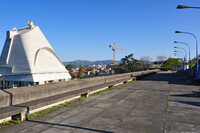| dc.coverage.spatial | Site: Firminy, Rhône-Alpes, France | en_US |
| dc.coverage.temporal | 1966-1968 (creation) | en_US |
| dc.creator | Le Corbusier | en_US |
| dc.creator | Wogenscky, André | en_US |
| dc.date | 1966-1968 | en_US |
| dc.date.accessioned | 2013-07-29T19:21:04Z | |
| dc.date.available | 2013-07-29T19:21:04Z | |
| dc.date.issued | 1966-1968 | en_US |
| dc.identifier | 227685 | en_US |
| dc.identifier.other | archrefid: 2400 | en_US |
| dc.identifier.uri | http://hdl.handle.net/1721.3/135468 | |
| dc.description | Entrance plaza on the top tier of the stands, concrete benches along perimeter wall; roof of St. Pierre to the left; Le Corbusier was commissioned by Eugène Claudius-Petit, who became mayor of Firminy in 1953, to design a central ‘agora’ including a sports stadium, cultural centre and church, as well as the Unité (housing unit), which he organized as an ensemble around the bowl of an abandoned quarry. The ensemble was called "Firminy Vert' (Green Firminy) to mark a new beginning for what had been "Firminy Noir" (Black Firminy), a coal-mining town. André Wogenscky worked with Le Corbusier as early as 1945. He continued to work with Le Corbusier until the latter's death in 1965, becoming the Firminy Vert project manager at that point. Although the stadium had been part of the original design by Le Corbusier, it was solely executed by Wogenscky and Fernand Guardian, and was reduced in size from the original plan. It has 3800 seats, of which 500 are covered. The access point is the boulevard which rings the back and allows viewers to access the top tiers. The stands are facing the cultural centre across the playing field, which is the bottom of the bowl of the old quarry. There are plans to renovate the stadium and finish the cover to get to the original draft of 1000 covered seats. Source: Wikipedia; http://en.wikipedia.org/wiki/Main_Page (accessed 5/12/2011) | en_US |
| dc.format.medium | concrete | en_US |
| dc.rights | © Scott Gilchrist, Archivision, Inc. | en_US |
| dc.subject | architecture | en_US |
| dc.subject | recreation and games | en_US |
| dc.subject | festivals | en_US |
| dc.subject | athletics | en_US |
| dc.subject | sporting events | en_US |
| dc.subject | Twentieth century | en_US |
| dc.subject | Modernist | en_US |
| dc.title | Firminy-Vert Sports Arena | en_US |
| dc.title.alternative | Stade de Firminy-Vert | en_US |
| dc.title.alternative | Firminy Vert Stadium | en_US |
| dc.type | image | en_US |
| dc.rights.access | Licensed for educational and research use by the MIT community only | en_US |
| dc.identifier.vendorcode | 1A1-LC-FV-SA-A25 | en_US |
| vra.culturalContext | French | en_US |
| vra.technique | construction (assembling) | en_US |
| vra.worktype | sports complex | en_US |
| vra.worktype | stadium | en_US |
| dc.contributor.display | André Wogenscky (French architect, 1916-2004); Le Corbusier (Swiss architect, 1887-1965) | en_US |


